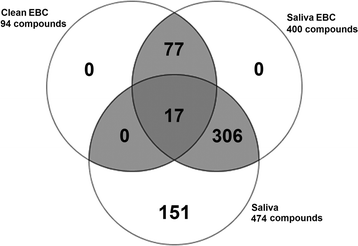Determining the presence of asthma-related molecules and salivary contamination in exhaled breath condensate
- PMID: 28403875
- PMCID: PMC5389118
- DOI: 10.1186/s12931-017-0538-5
Determining the presence of asthma-related molecules and salivary contamination in exhaled breath condensate
Abstract
Background: Researchers investigating lung diseases, such as asthma, have questioned whether certain compounds previously reported in exhaled breath condensate (EBC) originate from saliva contamination. Moreover, despite its increasing use in 'omics profiling studies, the constituents of EBC remain largely uncharacterized. The present study aims to define the usefulness of EBC in investigating lung disease by comparing EBC, saliva, and saliva-contaminated EBC using targeted and untargeted mass spectrometry and the potential of metabolite loss from adsorption to EBC sample collection tubes.
Methods: Liquid chromatography mass spectrometry (LC-MS) was used to analyze samples from 133 individuals from three different cohorts. Levels of amino acids and eicosanoids, two classes of molecules previously reported in EBC and saliva, were measured using targeted LC-MS. Cohort 1 was used to examine contamination of EBC by saliva. Samples from Cohort 1 consisted of clean EBC, saliva-contaminated EBC, and clean saliva from 13 healthy volunteers; samples were analyzed using untargeted LC-MS. Cohort 2 was used to compare eicosanoid levels from matched EBC and saliva collected from 107 asthmatic subjects. Samples were analyzed using both targeted and untargeted LC-MS. Cohort 3 samples consisted of clean-EBC collected from 13 subjects, including smokers and non-smokers, and were used to independently confirm findings; samples were analyzed using targeted LC-MS, untargeted LC-MS, and proteomics. In addition to human samples, an in-house developed nebulizing system was used to determine the potential for EBC samples to be contaminated by saliva.
Results: Out of the 400 metabolites detected in both EBC and saliva, 77 were specific to EBC; however, EBC samples were concentrated 20-fold to achieve this level of sensitivity. Amino acid concentrations ranged from 196 pg/mL - 4 μg/mL (clean EBC), 1.98 ng/mL - 6 μg/mL (saliva-contaminated EBC), and 13.84 ng/mL - 1256 mg/mL (saliva). Eicosanoid concentration ranges were an order of magnitude lower; 10 pg/mL - 76.5 ng/mL (clean EBC), 10 pg/mL - 898 ng/mL (saliva-contaminated EBC), and 2.54 ng/mL - 272.9 mg/mL (saliva). Although the sample size of the replication cohort (Cohort 3) did not allow for statistical comparisons, two proteins and 19 eicosanoids were detected in smoker vs. non-smoker clean-EBC.
Conclusions: We conclude that metabolites are present and detectable in EBC using LC-MS; however, a large starting volume of sample is required.
Keywords: Amino acids; Asthma; EBC; Eicosanoids; LC-MS; Leukotriene; Lung; Metabolomics; Proteomics; Saliva.
Figures





Similar articles
-
LC/MS/MS analysis of leukotriene B4 and other eicosanoids in exhaled breath condensate for assessing lung inflammation.J Chromatogr B Analyt Technol Biomed Life Sci. 2009 May 1;877(13):1272-80. doi: 10.1016/j.jchromb.2009.01.036. Epub 2009 Feb 2. J Chromatogr B Analyt Technol Biomed Life Sci. 2009. PMID: 19233745 Review.
-
Bioanalysis of underivatized amino acids in non-invasive exhaled breath condensate samples using liquid chromatography coupled with tandem mass spectrometry.J Chromatogr A. 2018 Mar 23;1542:72-81. doi: 10.1016/j.chroma.2018.02.019. Epub 2018 Feb 12. J Chromatogr A. 2018. PMID: 29477235
-
Exhaled breath condensate eicosanoid levels associate with asthma and its severity.J Allergy Clin Immunol. 2013 Sep;132(3):547-553. doi: 10.1016/j.jaci.2013.01.058. Epub 2013 Apr 19. J Allergy Clin Immunol. 2013. PMID: 23608729 Free PMC article.
-
Profile of eicosanoids in breath condensate in asthma and COPD.J Breath Res. 2012 Jun;6(2):026001. doi: 10.1088/1752-7155/6/2/026001. Epub 2012 Mar 27. J Breath Res. 2012. PMID: 22451217
-
Liquid chromatography-mass spectrometry measurement of leukotrienes in asthma and other respiratory diseases.J Chromatogr B Analyt Technol Biomed Life Sci. 2014 Aug 1;964:12-25. doi: 10.1016/j.jchromb.2014.02.059. Epub 2014 Mar 12. J Chromatogr B Analyt Technol Biomed Life Sci. 2014. PMID: 24656639 Review.
Cited by
-
Determination of thiocyanate in exhaled breath condensate.Free Radic Biol Med. 2018 Oct;126:334-340. doi: 10.1016/j.freeradbiomed.2018.08.012. Epub 2018 Aug 22. Free Radic Biol Med. 2018. PMID: 30144632 Free PMC article.
-
Metabolomics in asthma: A platform for discovery.Mol Aspects Med. 2022 Jun;85:100990. doi: 10.1016/j.mam.2021.100990. Epub 2021 Jul 17. Mol Aspects Med. 2022. PMID: 34281719 Free PMC article. Review.
-
Mass Spectrometry Analysis of the Exhaled Breath Condensate and Proposal of Dermcidin and S100A9 as Possible Markers for Lung Cancer Prognosis.Lung. 2019 Aug;197(4):523-531. doi: 10.1007/s00408-019-00238-z. Epub 2019 May 21. Lung. 2019. PMID: 31115649
-
Mass Spectrometry-Based Human Breath Analysis: Towards COVID-19 Diagnosis and Research.J Anal Test. 2021;5(4):287-297. doi: 10.1007/s41664-021-00194-9. Epub 2021 Aug 16. J Anal Test. 2021. PMID: 34422436 Free PMC article. Review.
-
Applied body-fluid analysis by wearable devices.Nature. 2024 Dec;636(8041):57-68. doi: 10.1038/s41586-024-08249-4. Epub 2024 Dec 4. Nature. 2024. PMID: 39633192 Review.
References
-
- Brzozowska A, Majak P, Jerzyńska J, Smejda K, Bobrowska-Korzeniowska M, Stelmach W, et al. Exhaled nitric oxide correlates with IL-2, MCP-1, PDGF-BB and TIMP-2 in exhaled breath condensate of children with refractory asthma. Adv Dermatol Allergol. 2015;32(2):107–13. doi: 10.5114/pdia.2014.40953. - DOI - PMC - PubMed
-
- Esther CR, Jr, Boysen G, Olsen BM, Collins LB, Ghio AJ, Swenberg JW, et al. Mass spectrometric analysis of biomarkers and dilution markers in exhaled breath condensate reveals elevated purines in asthma and cystic fibrosis. Am J Physiol Lung Cell Mol Physiol. 2009;296(6):L987–L93. doi: 10.1152/ajplung.90512.2008. - DOI - PMC - PubMed
Publication types
MeSH terms
Substances
Grants and funding
LinkOut - more resources
Full Text Sources
Other Literature Sources
Medical

